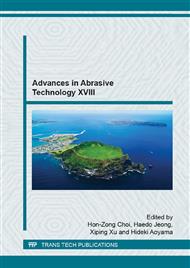p.9
p.15
p.21
p.30
p.36
p.42
p.48
p.54
p.60
Dental Grinding of Lithium Disilicate Ceramic Prostheses Using High-Speed Rotary Cutting Instruments in In Vitro Oral Adjusting
Abstract:
Oral adjusting of ceramic prostheses involving abrasive machining using dental high-speed rotary cutting instruments is a central process in restorative dentistry, because this process affects not only restorative quality but also patients’ comfort. However, the dental grinding process, especially dental grinding of high-strength ceramic prostheses, is less understood in clinical dentistry. This paper presents dental grinding of an innovative high-strength lithium disilicate ceramic in in vitro oral adjusting regime using a dental high-speed electric handpiece and diamond burs. The dental abrasive machining characteristics were quantitatively evaluated in terms of normal and tangential forces, force ratio, and specific grinding energy as functions of clinically relevant dental grinding variables including depth of cut and feed rate and feed direction of burs. The results showed that the dental tangential and normal forces and specific grinding energy exhibited significant dependences on depth of cut, feed rate and direction of burs, but revealed significantly small scales compared to engineering machining regime. Clinical implication was given that down grinding undoubtedly reduced the abrasive adjusting forces to relieve patients’ discomfort in oral regime. Moreover, dentists must be cautious in dental abrasive adjusting of the lithium disilicate ceramic prostheses at or beyond the specific material removal rate of 2.4 mm3/min due to significantly large forces and vibrations.
Info:
Periodical:
Pages:
36-41
Citation:
Online since:
January 2016
Authors:
Price:
Сopyright:
© 2016 Trans Tech Publications Ltd. All Rights Reserved
Share:
Citation:


